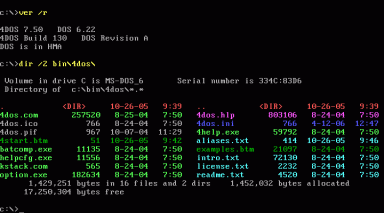
4DOS
Launched: 1989
4DOS is a command line interpreter that replaces command.com and adds many new features.
4DOS is a command line interpreter from JP Software, designed to replace the default COMMAND.COM shell in Microsoft DOS and Windows. It was written by Rex C. Conn and Tom Rawson and first published in 1989. Compared to the default, it has a number of improvements.
4OS2 and 4NT are similar products that replace cmd.exe in OS/2 and Windows NT, respectively.
Overview
4DOS is most often used as a command line replacement for the following operating systems:
Command line: MS-DOS, IBM PC DOS, DR-DOS.
Graphical environment: Windows 95 to Windows 98, Windows 98SE.
Since Windows NT and Windows 2000 include both COMMAND.COM and cmd.exe, both 4DOS and 4NT and derivatives can be installed. Previous versions of 4OS2 can run under Windows NT, and OS/2 can run both DOS and Windows NT shells; all three can be used on Windows NT-like machines and on multiboot OS/2 machines.
Among the many 4DOS commands, statements, and functions missing from the MS-DOS/Windows 95-98 COMMAND.COM are keyboard input reading and a simpler method of working with screen colors and text.
The default file extension for 4DOS scripts is .btm.
A graphical version of 4DOS, 4OS2, and 4NT, called Take Command, was released with a feature set corresponding to 4DOS 5.5, 4OS2, and 4NT 2.5, and was updated afterward. Development in this line ceased with the corresponding text-mode versions. A graphical program, Take Command/16, existed for Windows 3.1.
4OS2 is a similar replacement for IBM's OS/2 shell. It was first released at the same time as 4DOS version 4 and has a similar feature set. Like 4DOS, it is open source. It appeared in the 2011 eComStation 2.10 feature set, in the free os2free project, and is included with ArcaOS.
4NT was first released as 4DOS for Windows NT (versions 1.x and 2.x), but remained 4NT until the refactoring after version 8. The program is a recompilation of 4OS2 and retains features of the OS/2 command processor (cmd.exe), such as REXX script execution and EXTPROC support. A corresponding Take Command/32 exists for this purpose, version 1 of which corresponds to 4NT 2.5. 4NT and Take Command/32 were released in both ANSI (Windows 9x) and Unicode (Windows NT) formats, with the ANSI version being dropped in version 5.
A new Win32 Tabbed Command Interface (TCI) program was released with 4NT version 7. This program allowed tabbed consoles to be attached (thus reducing screen clutter) and detached into a single window. This program requires Windows XP or later.
A new version of Take Command extends the original Tabbed Command Interface, extending it with additional windows to allow composing input, graphical navigation through directories and files, and additional features. 4NT is included as the Take Command Console. A reduced-feature version of TCC is available as a free download.
Next, JP Software releases
TC (TCI + TCC complete package)
TCLE (TCI + TCC/LE)
TCC (Command Utility only)
TCC/LE
Versions 9 through 12.1 have been released, corresponding to the underlying 4NT/TCC version.
Features
4DOS introduces several improvements over COMMAND.COM:
Additional Commands
Extended functionality of existing commands
Extended batch file processing facilities
Improved command line editing, including filename completion and command history
Support for command aliases, including in scripts
Improved wildcards and the ability to filter by file size, date and time, and other file characteristics
Extended syntax for redirection and piping
Context-sensitive help
Colored directory listings
Internal variables and variable functions
Memory swapping mechanism that allows more conventional memory to be freed up.
Interactive debugger for batch files
Mechanism for creating, maintaining, and viewing file descriptions.
Configuration stored in an INI file
Windows clipboard support
History
Originally distributed as shareware, 4DOS has subsequently been released as unsupported freeware. The source code is currently available under a modified MIT license, but "may not be used in any commercial product without the written permission of Rex C. Conn" and "may not be compiled for use on any operating system other than FreeDOS"—thus not qualifying as open source according to the Open Source Initiative definition.
JP Software's last update was version 7.50.130, released in August 2004. Over its 15-year history, 4DOS has undergone numerous updates; these are some of the most significant.
4DOS versions
| Year | Ver. |
|---|---|
| 1989 | 2.00 first MS-DOS Original release. Improved command line editing, file name completion, command history, aliases, improved wildcards, online help, internal variables, swap to disk or EMS, file descriptions, command separator, key stacker. |
| 1989 | 2.20 MS-DOS Executable extensions. |
| 1990 | 3.00 MS-DOS BTM batch files (cached for speed), extended memory swap (XMS), variable functions, variable name syntax in parentheses. |
| 1991 | 4.00 MS-DOS Colored directory lists, 4DOS.INI configuration file, inclusion lists, command groups, implicit CDD, DOS 5 Upper Memory Blocks (UMB) compatibility. |
| 1993 | 5.00 MS-DOS Date, time, and size ranges; compressed batch files. |
| 1995 | 5.51 MS-DOS Support for long file names, REXX in .BAT files (as in PC DOS 7.0). |
| 1997 | 6.00 MS-DOS Extended directory searches, interactive configuration (OPTION command), exclusion ranges, interactive batch file debugger. |
| 2001 | 7.00 MS-DOS @file lists (as in DR-DOS). |
| 2003 | 7.50 MS-DOS User-defined functions. |
| 2006 | 7.50.1 MS-DOS Open source version of 7.50. Luchezar Georgiev and Jaelani Utomo have continued developing 4DOS. |
| 2009 | 8.00 last MS-DOS Last version. |